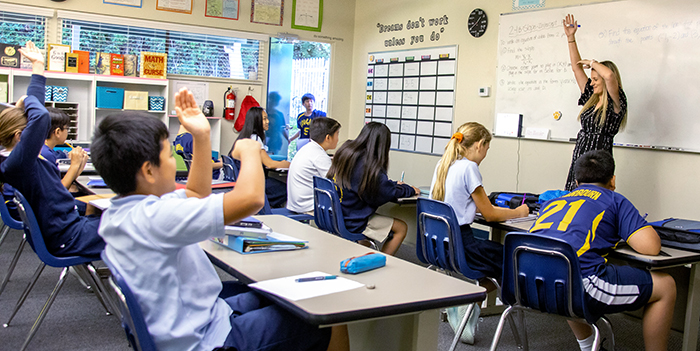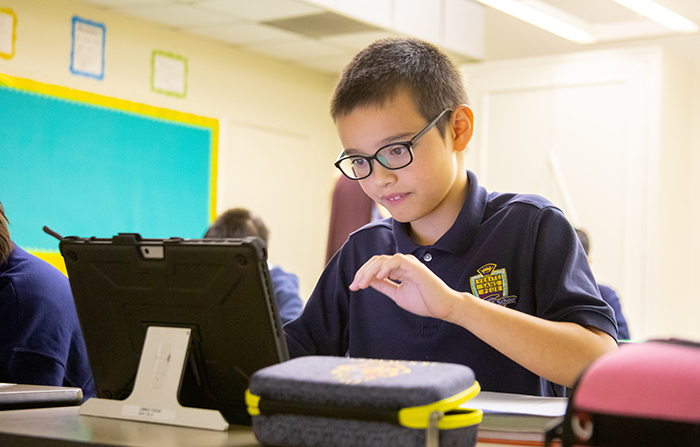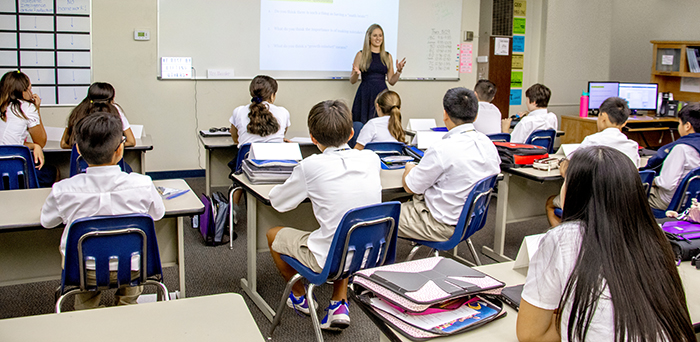
Clairbourn School’s Middle School Math Teacher, Rebecca Messler, returned from winter break excited to share with her fellow teachers powerful ideas gleaned from the California Mathematics Council South Conference which she attended in mid-November of 2019.
This conference, offering hundreds of sessions and packed with several thousand math teachers, proved to be a power-house of great information! Messler attended eight sessions applicable to teaching middle school math. Highlights included presentations from two important thought-leaders in math education, Jo Boaler (a Stanford professor, research, and author) as well as Dan Myer (speaker, former teacher, and the chief academic officer of Desmos.com which, is Messler’s favorite math exploration and education support website).
At the Clairbourn staff development meeting in January, Messler chose to share with everyone the idea from the conference of incorporating “Rich Open-Ended Tasks” (ROET) into their teaching methods. She explained this simple concept can be easily implemented and produces stronger engagement and increased understanding of subject matter among students with differentiated learning styles.

___________
With ROET, students can reach one of many solutions from a variety of paths. This helps students to stretch beyond what they already know, develop a spirit of inquiry, and practice persistence.
___________
What is a ROET? It is a type of educational task that involves students in making connections with the learning material on a whole new level. They have to consider open-ended problems, they have to add missing information pulled from their own interests, and they have to reach one of many solutions available from a variety of paths. This approach helps students to stretch beyond what they already know, develop a spirit of inquiry, and practice persistence. It also helps material stick in their minds because learning is combined with their personal interests.

___________
ROETs have no obvious procedures to follow, and this allows every student to access the information in a way that makes sense to them and to form their own mental deep-dive into the concepts.
___________
The ROET method stands in stark contrast to a typical one-sided interaction where teachers provide students with a pre-determined path to arrive at a single answer. (It should come as no surprise that few students enjoy passively receiving robotic instructions to follow.) With ROET tasks, learning becomes a shared responsibility between the teacher and the student. ROETs have no obvious procedures to follow, and this allows every student to access the information in a way that makes sense to them and to form their own mental deep-dive into the concepts. In the study of mathematics, ROETs also help students understand how to construct their own mathematical arguments.

It is important to note at this point, that ROETs do not replace the value of straight practice problems or repetitive mastery of concepts in the classroom. Learning must be a combination of these things! But, by adding ROET tasks to the mix, students can enjoy the benefits of traditional math education techniques side-by-side with modern, differentiated methods that expand students’ access to math concepts and their enjoyment and understanding of the subject matter.
___________
…math questions are open-ended and are treated as a problem-solving process, a way of critical thinking—something to talk about and discuss—requiring student involvement.
___________
Messler demonstrated to her fellow teachers how she starts each class with a math question, designed to illustrate a need for that math skill, with students involved as co-creators of the process. (This is in contrast to demonstrating a sequence of pre-determined steps to solve a word-problem with one right answer at the end of the task). Instead, her math questions are open-ended and are treated as a problem-solving process, a way of critical thinking—something to talk about and discuss—requiring student involvement.
The open-ended questions create multiple entry points into concepts. Students are able to approach math questions on their own level and expand from that starting point. As each new question is introduced, students find their learning sessions turn into engaging investigations and inquiries where they seek to understand why math rules exist and how they function.

As part of her demonstration, Messler shared a worksheet, completed by her students, showing that students could insert either easy-to-work-with numbers or could employ complex numbers. Either pathway allowed them to demonstrate their understanding of the concept of unit rates. Students could choose to increase the problem’s difficulty by adding in other skills or by changing up the units used in the task. They had options to create problems with fractions or could even develop a backwards problem allowing them to expand upon the original question.
__________
…students must change their thinking from “What does the teacher want me to do?” to “What can I do?”
___________
ROET tasks, such as the one shared by Messler, make it quickly apparent that students must change their thinking from “What does the teacher want me to do?” to “What can I do?” thus allowing students to puzzle over a problem, persevere in solution development, and shift into idea-generators.

To wrap-up her presentation, Messler shared four strategies to help teachers adapt learning tasks into ROET activities. The strategies are:
A. Make it Headless – A headless word problem asks a question, but is missing any information required to find a solution. 1An example of a headless word problem is “How long will it take Mary to drive to Chicago?” Students can then discuss what information they require to answer the question and what questions can be asked about the situation. That puts them in a good position to then generate information required to make a complete word problem.
B. Make it Tailless – A tailless word problem is missing a question to solve after an introductory statement. In this scenario, students must generate their own ideas on how to use the information provided in the introductory statement to arrive at their own questions. 1An example of a tailless word problem is “I have 17 cents.” Students can then ask themselves how they can use the information. This will enable them to generate discussions around the statement and make observations like “You must have at least two pennies,” or “You can’t have any quarters,” or “You can only have one dime.” They can also develop a chart showing the possible coin combinations. After discussion, they can generate questions such as, “If I have nine coins, which coins do I have?” or “If I have more nickels than pennies, how many coins do I have?”
C. Make it Numberless – A numberless word problem is where both the numbers and the question is removed. 2For example, “There are some kids on the bus. More kids get on the bus. Now there are lots of kids on the bus.” Students can then be asked what information exists in these statements and what math do they see? They might reply, “The bus already has kids on it,” or “I see addition because more kids are getting on the bus.” Students can then come up with questions relating to the problem, like “How many more students got on the bus?”, “How many students were riding the bus in the first place?”, or how many students total are on the bus after everyone boards?” The next step is to ask students what additional information is needed to answer the questions they generated. They will mostly likely figure out they need two out of the three numbers to find a solution.
D. Make it Open – An open-ended problem will have a variety of possible solution paths that range from simple to complex. 3For example, a problem to find the perimeter of a rectangle when its sides are given, can be changed into a problem where students are asked to give two different rectangles with a given perimeter. The new modified open task is now one that will cause students to learn and grow in their thinking instead of simply completing a performance task.
1 See the full explanation of this tailless and
headless math problem at: https://blog.heinemann.com/tailheadless-wordproblems-tta
2 See the full explanation of this numberless word problem at:
https://www.primaryblissteaching.com/numberless-math-word-problems-a-strategy-that-works/
3 See the explanatory video from Jo Boaler here: https://www.mathmammoth.com/lessons/from_closed_math_problems_to_open.php
Clairbourn School Provides Private School Education for Preschool, Kindergarten, Elementary School, and Middle School Grades | Serving Families in the Pasadena, California, Area and Surrounding Cities (K-12 Private Schools) Clairbourn is a 501(c)3 charitable organization. Click here to request information.
Creating Scholars and Leaders with Heart
